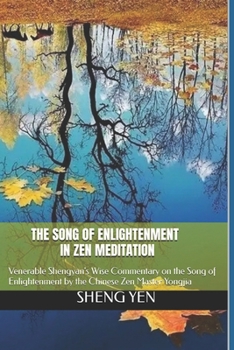The Song of Enlightenment in Zen Meditation: Venerable Shengyan's Wise Commentary on the Song of Enlightenment by the Chinese Zen Master Yongjia
The Song of Enlightenment by Master Yongjia (Yongjia Xuanjue, 665-713 AD) is a classic of Chinese Zen Buddhism, renowned for its profound content. This song encapsulates the core teachings and practices of Zen Buddhism, summarizing its understanding of enlightenment and methods of practice. Here are the key points of "The Song of Enlightenment"
Emphasis on the Essence of Enlightenment: The song emphasizes that the essence of enlightenment lies in realizing one's true nature, transcending appearances and attachments, and directly experiencing one's authentic self.
Depiction of the States of Zen Practice: It portrays the states experienced by practitioners in the process of cultivation, including transcending duality, letting go of attachments, and transcending life and death.
Emphasis on the Purity of Mind: It emphasizes the inherent purity of the mind and the practice of removing distracting thoughts through meditation to return to one's original nature.
Advocacy for Thoughtlessness and Formlessness: It emphasizes the state of being without thought or form, transcending the constraints of thinking and concepts, and directly experiencing the reality of the present moment.
Emphasis on the Importance of Practice: It highlights the importance of practice, asserting that true comprehension of the profound meaning of Zen Buddhism can only be achieved through personal practice.
These are the core teachings of "The Song of Enlightenment," reflecting Zen Buddhism's profound understanding of enlightenment and practice, placing high demands on practitioners and guiding them toward spiritual liberation and awakening.
Authentic Reflections After Reading This book is written in the form of talks given by Master Sheng Yen during a seven day retreat. This is an excellent book for people who have started a meditation practice and want guidance and motivation. It is not a how-to-position-your-body-for-meditation book. Master Sheng Yen also explains the lines of a Buddhist poem to structure his casual talks. I have read over a dozen books about meditation, and I have learned something from each one. But this book stands out among them because it comes closest to having a regular meditation teacher. After I meditated for seven months, I started feeling doubt about the practice, and this book helped greatly by inspiring me to continue. The first time I read this book, I put post-it tabs next to the parts to read again. I reread the parts whenever I feel discouraged or unenthusiastic about meditation, and it helps motivate me. I have to warn that the first twenty-two pages of the book may be frustrating because of the contradictory descriptions of buddha nature, which people who have read other books about Buddhism may be familiar with. I recommend to just skim past the first twenty-two pages, and then BAM--the book's tone changes. The rest of the book is fantastic. The writing style is gentle and humble, and it is full of wisdom and a few bits of unexpected humor. Master Sheng Yen was from the Chan Buddhist sect; Zen is the Japanese word for Chan. Although most of the book is about sitting meditation, he also wrote briefly about the Linji (Rinzai in Japanese) practices of huatou and gongan (koan in Japanese) and silent illumination (just sitting in Japanese) which is a Caodong practice (Soto in Japanese).Related Subjects
Philosophy




